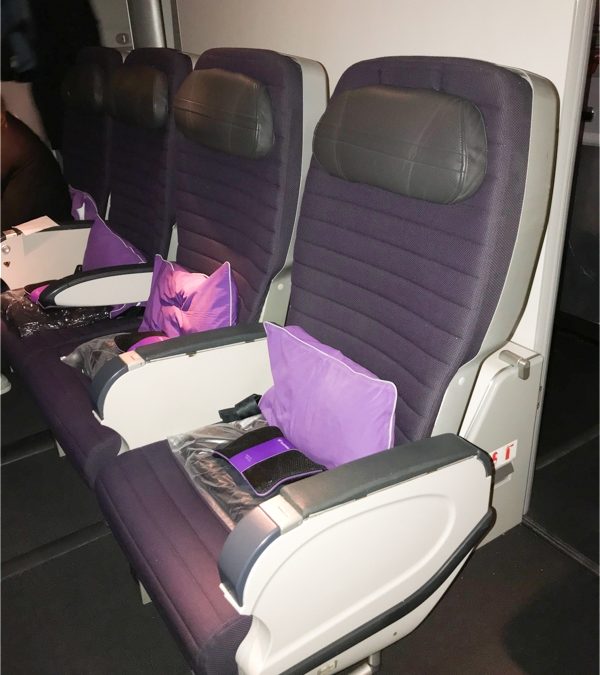
by Editor | Jan 6, 2020 | Luxury Travel
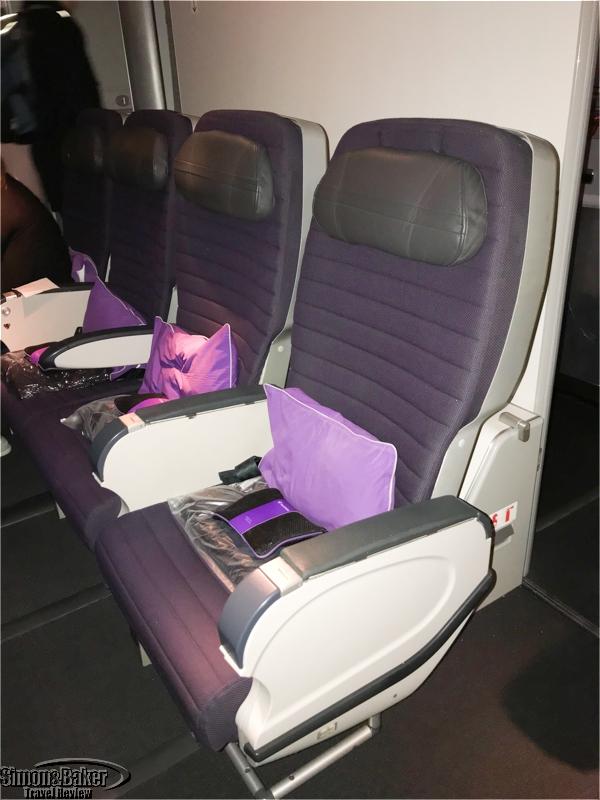
Middle seats on the better than economy section
I was thrilled at the prospect of visiting New Zealand, but finding a comfortable flight from the United States to New Zealand that didn’t break my travel spirit because of the length of the flight or my budget was so challenging I almost cancelled my trip. Although flying time on the United States to New Zealand flights was better than the longer flying time required on flights with connections en route to New Zealand the cost of the United States to New Zealand flights was 30 percent or more greater than I wanted to spend, and that was for an economy seat. Given the length of travel (some itineraries I found, alone and with the help of “expert” travel agents, exceeded 50 hours of travel, including sometimes 12 hour and longer layovers) I wanted something better than economy.
After days of searching and talking to 12 or more airline and travel specialists I found a combination of flying time, comfort and price I could live with on Virgin Australia International. Unfortunately the only routing possible was through Los Angeles. That airport, I soon discovered, was undergoing renovations involving extensive construction work.
Despite my best efforts and hours long conversations with the carrier it was impossible to book the flight as a single ticket from my departure airport. With the aid of a supervisor I booked two domestic connections to Los Angeles as a stand alone ticket. From there I flew Virgin Australia International to New Zealand via Australia on its slightly better than economy class fare, International Long Haul Premium.
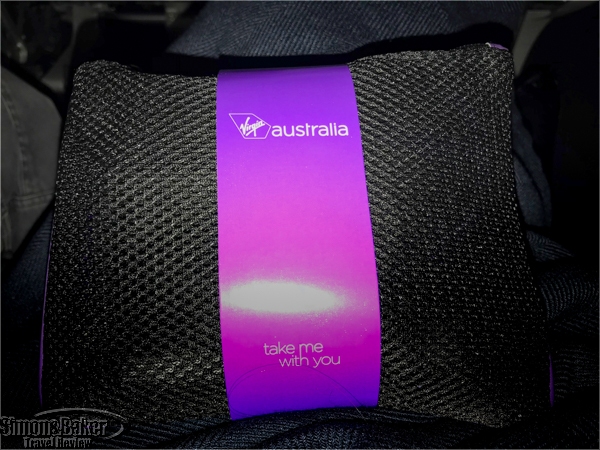
The Virgin Australia amenity kit
Arriving at LAX while it was under construction was no fun. As there was no universal agreement on the amount of time necessary for me to connect from my domestic to my international flights (three hours minimum was the common advice, more if possible) I booked an extra long layover. Once I was off of my domestic flight I had to collect my luggage from the domestic flight terminal, exit, make my way to another concourse (it was rather challenging to discover the path or distance involved in advance), pass through security, and check in for my Virgin Australia flight.
The lounge at LAX where I waited for my connection looked tired and unimpressive. As boarding time neared I was eager to board the flight to Brisbane although it meant the longest connection in my trip. Once on the aircraft the section set aside for Premium economy passengers looked slightly better than I had dared hope. I was in an aisle seat in row 16. The seat leaned back partway and was comfortable enough although the ambient temperature was uncomfortably chilly for most of the flight. Even my neighbor, a tall man from the Midwest used to cold winters, made use of the small synthetic fabric that passed for a “luxurious” blanket. The return flight to Los Angeles from Australia had the same uncomfortable frigid conditions.
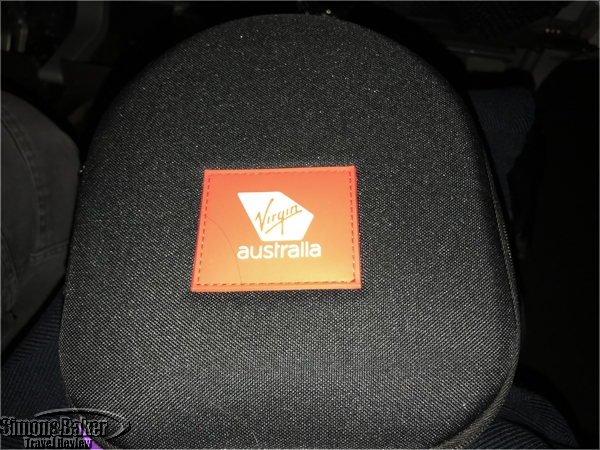
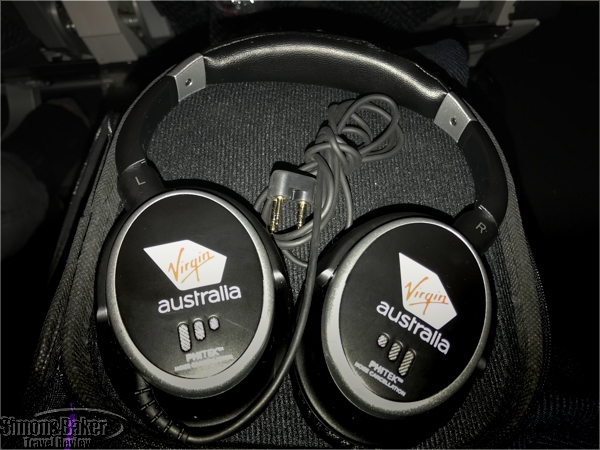
In order to carry fewer items on the trip I left my noise canceling headphones at home and was pleased to find a headset for my use on board.
Amenities included 41 inch seat pitch and nine inch recline, according to the airline’s website (I didn’t measure them); as well as 10.6 inch Seatback In-flight entertainment screen, noise cancelling headset, in-seat electrical power and USB connectivity. My entertainment system was functional as was the headset on both flights. The flights from Australia to New Zealand and back were Economy.
On the International Long Haul Premium flights everything was much better than on the Economy service for the same carrier. Although the printed menu promised delicious meals when they arrived it was the usual overcooked airline food. After the meal service and before the pre-landing snack a few self-serve snacks and beverages were available from a refrigerator. After a while the snacks disappeared. My favorite was the dark chocolate and coconut bar, an Australian flavor of a well known brand. Only one was on offer on my United States bound flight. On the outbound flight I didn’t sample any wines. On the return, they were out of the New Zealand wine of my choice from the wine list.
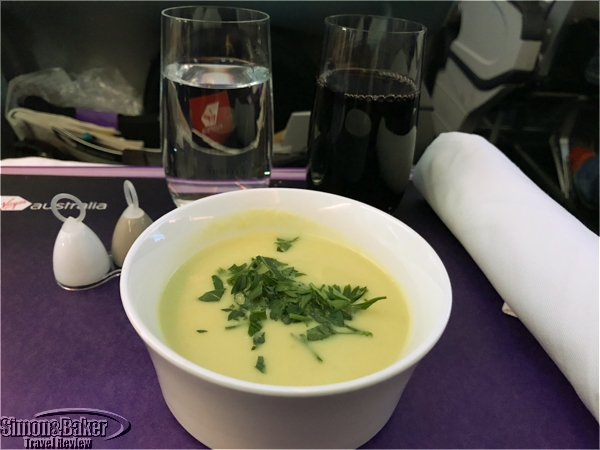
The staff were friendly and attentive on departure. After that the service waned. The first flight from the United States to Brisbane, Australia offered the best service of the four Virgin Australia International flights. It was far superior than the service on the domestic carrier stateside.
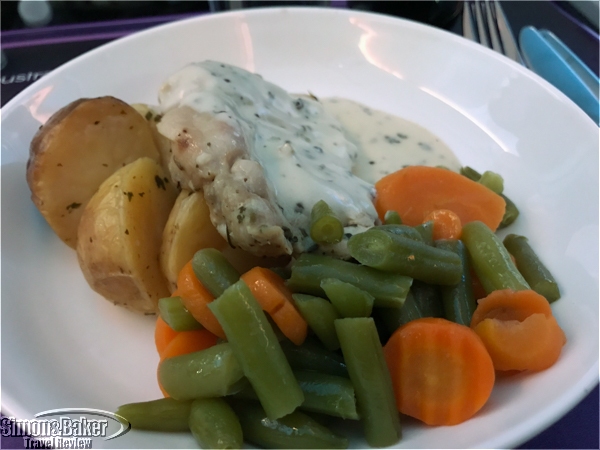
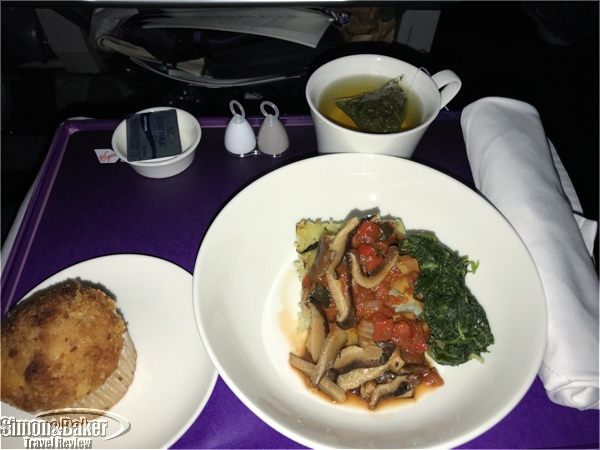
My hours of travel were long and I was exhausted on arrival in New Zealand to a crowded airport with long lines, brusque and impatient staff and strict customs rules. The 30 percent savings in the airfare combined with the shorter flying hours, slight onboard comforts, extra space and intimate section (the Premium seats were in a section of their own between business and economy) made the purchase worthwhile. Overall I was pleased with my selection of flights and ticket price. Based on the two flights from LAX to Australia I would fly Virgin Australia International’s International Long Haul Premium again.
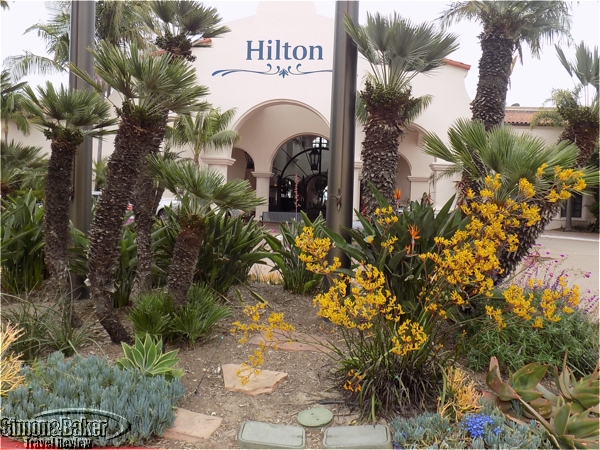
by Editor | Aug 26, 2019 | Accomodations, Luxury Travel
Article and photos by Scott S. Smith

The entrance to the recently remodeled Hilton Santa Barbara Beachfront Resort
The first Hilton my wife, Sandra Wells, and I ever stayed at was the Hilton Santa Barbara Beachfront Resort (633 East Cabrillo Boulevard, Santa Barbara, California 93103, +1 805 – 564-4333, text +1 805 – 465-9770, fax +1 805 – 564-4964, reservations 800/879-2929, https://www.hiltonsantabarbarabeachfrontresort.com/) in June 2019. In 2018, it had undergone a $15 million redesign and renovation. It had previously been a Double Tree, a Hilton brand, part of its 30-year partnership with the family of actor Fess Parker. The location was where a roundhouse for the Southern Pacific Railroad was built in 1911 and demolished in 1982 to make way for the resort, opened in 1986 (hence, the name of the hotel’s breakfast room, The Roundhouse).
The initial view of the hotel was striking: it had three levels and was spread out over 24 acres with large lawns, with a pale exterior and red tile roof, a design inspired from the Spanish heritage of California. Santa Barbarans like their buildings to fit into the environment, rather than being tall monuments to corporate egos that demand the highest possible viewpoint. The hotel was within easy walking distance (about one mile) of Santa Barbara’s quaint downtown.

The lobby was open, airy and spacious with white and pastel colors.
Our check-in went smoothly, with well-informed and courteous associates trained, as general manager Chris Inman told us, “to get to know our guests so we can provide exceptional service with sincerity and authenticity.” Because we were two hours early for the hotel’s 4 p.m. check-in time (for an extra charge it was possible to book a room as early as 7 a.m.) we had to wait an hour while the staff completed the cleaning of Room 336. It was a King Bed Resort View Balcony in the Gardenia building connected to the lobby, priced at $335 that particular night. It came with a Daily Resort Charge card listing amenities, such as a two-hour bicycle rental ($30 value), basic Internet access for two (worth $12.95 and premium was available for an extra $15.95). Standard WiFi was ubiquitous throughout the hotel. Our room rate also included two bottles of bottled water in the room (a $7 value). Self-parking cost $25 a day (valet parking was $35). Shuttles provided complimentary transport from the Amtrak station and the Santa Barbara International Airport from 5 a.m. to 9 p.m. There was an electric vehicle charging station.
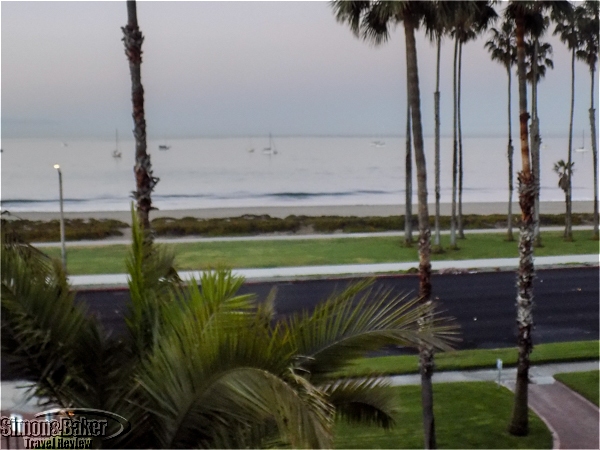
The view of East Beach from the Rotunda outside the lobby
The lobby was open, airy and spacious with white and pastel colors, perhaps an appropriate entry for a destination renowned for its mild climate and sophisticated, artsy culture. The hallway walls and carpets also were in subdued hues of turquoise, gold, gray, white with seascape paintings on the walls of public spaces and our room (the hallway walls were bare). The design was meant to provide a feeling of being in a calming oasis from the turbulence of the outside world, according to promotional materials.
Beyond the far doors of the lobby was the 20,000-square-foot open-air Plaza del Sol, suitable for dining and dancing, with stairs to the second level Rotunda, providing views of East Beach just beyond the lawn and highway (on the other side of the property are the low and lovely Santa Ynez Mountains).
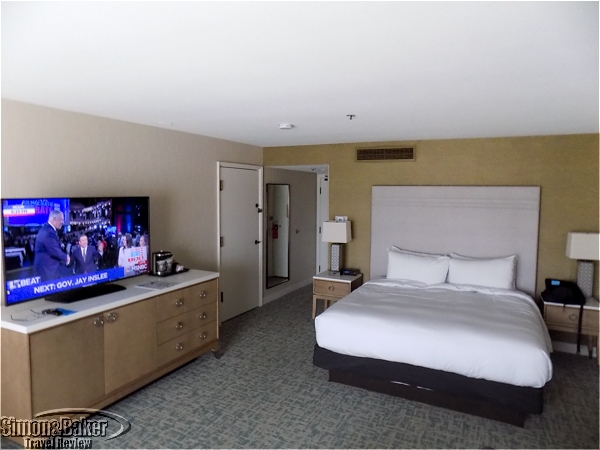
Our spacious (450 square feet) Hilton room
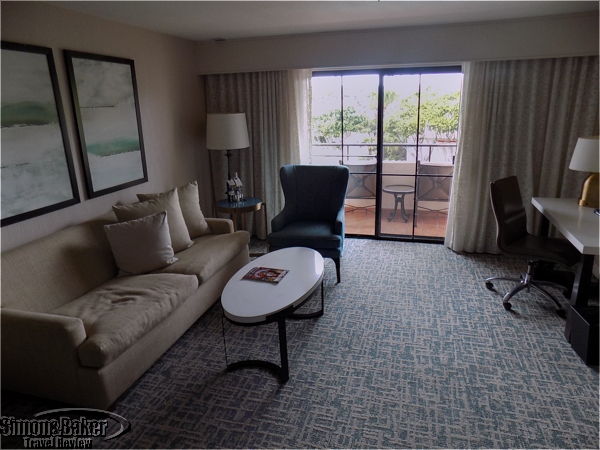
Some of the furniture in our room
In the lobby was the Fess Parker Wine Tasting Room with a self-service wine dispenser. At The Set restaurant there were photos from Parker’s career on the walls. He is best-remembered as the star of Disney’s Davy Crockett mini-series on ABC in 1955-56 (he was discovered by Walt himself and in 1991 was named a Disney Legend); and portraying Daniel Boone in an NBC series 1964-70. He bought hotels and a winery, which now has 1,500 acres of vineyards. His son and daughter run the company. He passed away in 2010. The logo on their bottles is a golden coonskin cap, a reminder of his most famous roles. The winery appeared under another name in the movie Sideways.
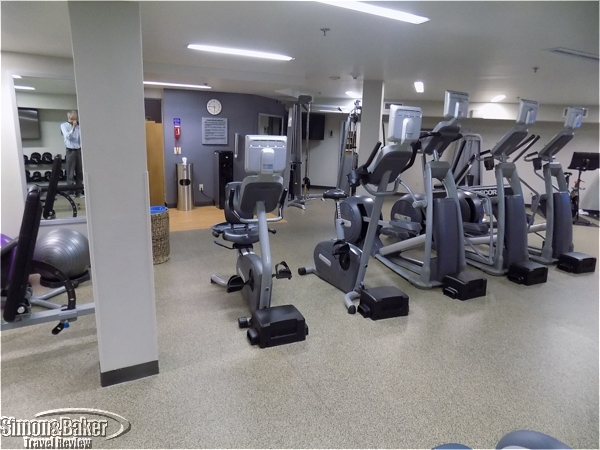
Partial view of the fitness center
The main floor had: business desk with a computer and printer, ATM, car rental desk, concierge, gift shop, fitness center, and salon and spa. The resort was pet-friendly. There was a $50 non-refundable cleaning charge per pet.
Our room was 450 square feet in size with an open design. It had the following security features: an automatic door closer, electronic locks, a secondary locking device, a thumb dead bolt, a wide-angle door viewer, and a hidden safe. We found the king-size mattress and pillows comfortable. We requested that our room not be cleaned during our overnight stay. We dispensed with the turn-down service, and noted the commendable policy that unless otherwise requested, linens were changed every three days to minimize impact on the environment.
Furnishings included beige oversized loveseat sofa bed, armchair, desk with chair, and large chest of drawers. In the closet there was an iron and full-size ironing board. Among the amenities was a landline with speaker phone and voicemail. In addition to the empty mini refrigerator, there was a bucket for the ice machine in the hallway next to the elevator. The flat-screen TV was a 55 inches LG LED with HBO, ESPN, and other premium cable channels. It was easy to use and turned on quickly.
The walls, ceiling, and carpet in our room adhered to the resort’s color scheme of white, beige, tan, gray, and turquoise. We liked that drawing the drapes made the room dark for sound sleeping (we had to cover the lighted clock when we were not using it as a night light). There were copies of USA Today and Santa Barbara Magazine in our room. There was a complimentary welcome tray with nuts, dried fruit, and cheese.
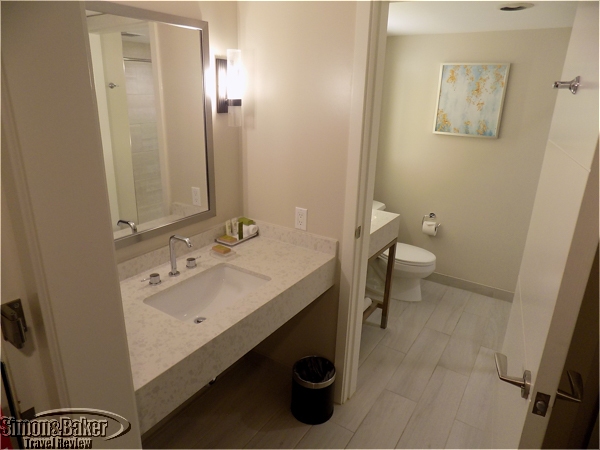
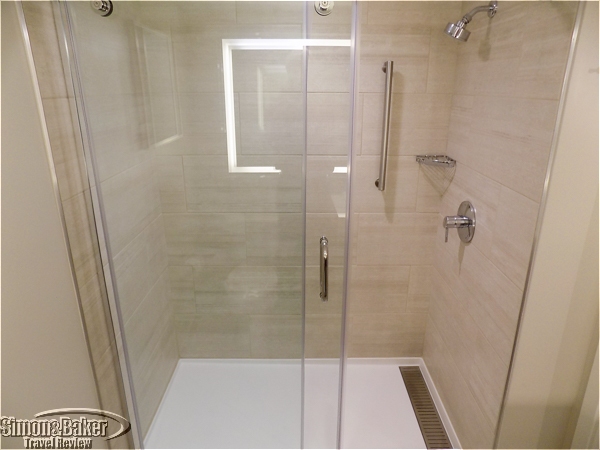
Our bathroom
The sink was deep and wide (9 inches x 14 inches), the water turned hot immediately, and there was plenty of counter space. The toilet flushed strongly. I found the bathroom lighting fine, while some hotels try to be sophisticated by setting it too soft. Sandra felt it was too bright and would have liked to have a magnifying mirror for makeup. The shower was easy to use (unlike some at top hotels that are annoyingly complicated), powerful, and the water came out hot quickly. Sandra would have preferred a wider spray option. The hairdryer was the powerful Conair 1875. The shampoo, conditioner, and soap were Crabtree & Evelyn. We forgot to bring toothbrushes, toothpaste, and a nail file. It would have been helpful to find those amenities in our room.
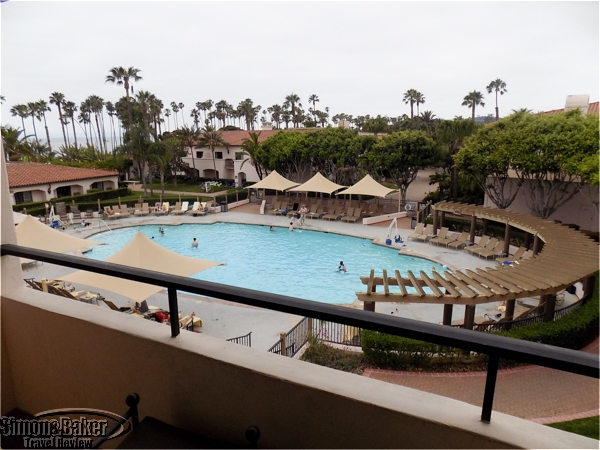
The pool view from our balcony
From our private balcony, furnished with a small round table and two chairs, we had a partial view of East Beach on the Pacific Ocean. The 85 feet by 50 feet swimming pool, was by far the largest we have ever seen at any hotel we have stayed at. The pool was open from 7 a.m. to 11 p.m. We had to delay our normal bedtime to 10 p.m. because the noise from the pool was so loud.
According to promotional materials, the hotel complied with the guidelines of Americans with Disabilities Act in guest and public areas from the restaurants to the fitness center. There was a handicapped lift for those who needed help entering the pool. Our room had a 32 inch clearance width; there were Braille room numbers and closed-captioning on TV; we understood that flashing lights would accompany the sound of fire alarms in public areas.
The Set was a bistro-style restaurant and full bar (featuring Fess Parker photos on the walls), with a patio for al fresco dining overlooking, in the background, the sea, and ever-burning outdoor fire pits. It was open from 11:30 a.m. to 11 p.m., including a Yappy Hour at 4 p.m. when pooches received complimentary dog biscuits (Happy Hour was 5 p.m. to 7 p.m.). The food was locally-sourced and inventive. The restaurant did not accept reservations. Because we were on a tight schedule, we had pre-ordered some menu items. We arrived early and changed our order. Anthony Fanella, director of food and beverage for the resort, ensured our new choices were prepared on time (he answered some of our questions about the hotel in general and introduced us to the Rotunda, which we might have overlooked, the perfect vantage point for a photo of East Beach).
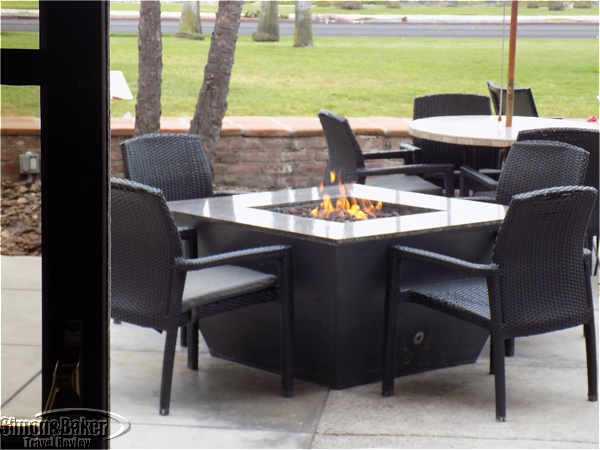
Al fresco dining
We shared a delicious and Tomato Soup au Gratin with aged cheddar ($12). We also tried the Tomato and Peach Salad, with Burrata mozzarella, pickled cherry tomato, arugula, mint, preserved lemon, olive oil, and aged balsamic ($17). I had the Kobe Burger with the plant-based Hungry Planet patty. I found it to be a perfect knock-off of a beef burger ($20). Sandra ordered the Quinoa Fricassee, with toy-box tomatoes, olives, caramelized onions, haricots verts, carrots, cauliflower, preserved lemon, piquillo peppers coulis, and thyme ($19). Our wait-person, Jay, was friendly and helpful. She had only been there a week and came from a popular high-end restaurant. We had a tasty and pleasant meal.
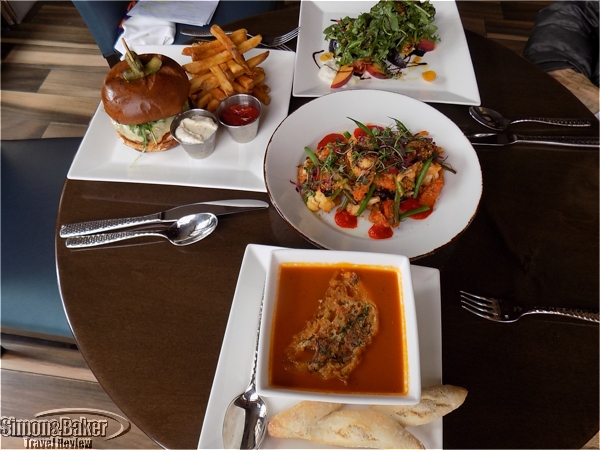
We shared a delicious Tomato Soup au Gratin with aged cheddar.
For breakfast we had the buffet in The Roundhouse ($58 for two plus tax and tip). I liked the Royal Coffee, while Sandra liked the chamomile and green tea blend. She enjoyed a custom-made vegetable-and-cheese omelet. She found the toaster too slow, yet it could suddenly burn, if not watched carefully. I liked the organic granola blend and honey milk, the granola and berry yogurt parfait, plain Greek yogurt with honey, and something I had never tried, overnight oats, which had been soaked in milk. We also sampled some of the ripe fruit and juices.
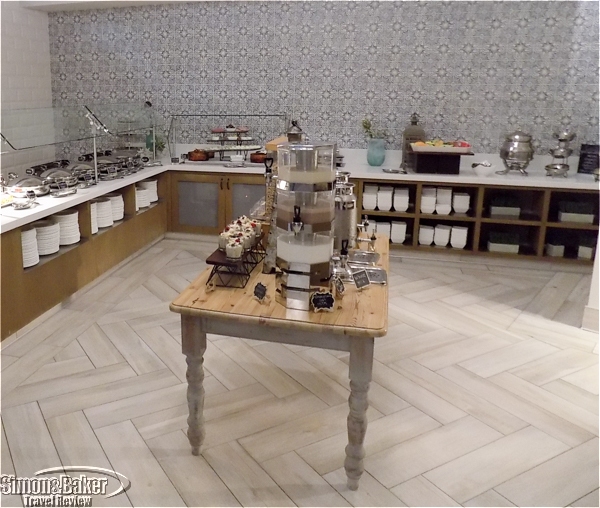
In the morning we had the buffet in The Roundhouse.
The property was a promising introduction to the new Hilton brand because the location and design were matched to support a relaxing and enjoyable experience with friendly and helpful staff, rather than formal and purely reactive, as at some top hotels. We are eager to try out some of the many other types of properties within the brand and the amenities we did not have an opportunity to experience this time.

by Editor | Aug 5, 2019 | Attractions, Ecotourism, Luxury Travel
Article and photos by Elena del Valle

Wayne Allanson aboard our 10-seat KeelowCraft on the 52 kilometer Waiatoto River in New Zealand
I didn’t know quite what to expect during the off the beaten track Waiatoto River Safari in the 355,000 hectare Aspiring National Park, part of the United Nations Educational, Scientific and Cultural Organization (U.N.E.S.C.O.) Te Wāhipounamu World Heritage Park in the South Island of New Zealand. My first clue was Ruth Allanson’s smile when we stopped to check in and sign release forms. It lit up her face and put me at ease. She and Wayne, her husband, owned the company.
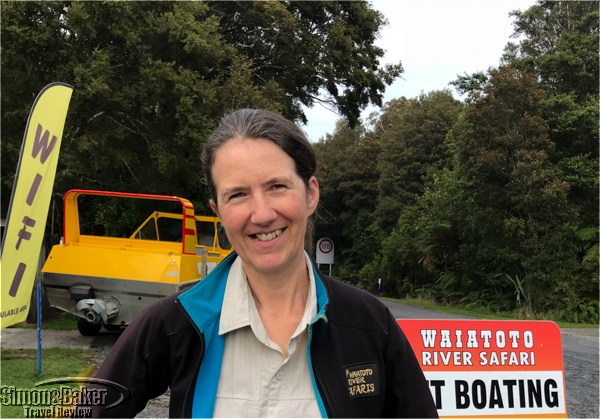
Ruth Allanson of Waiatoto River Safari

During the tour Wayne stopped in a sheltered corner of the river to tell us about the park.
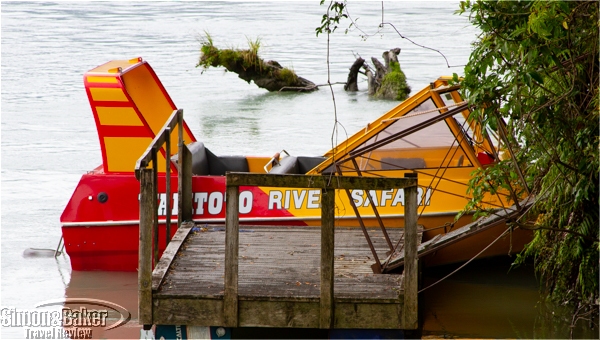
Our departure point
The simple indoor stand housed a desk, promotional brochures and a few local stonework souvenirs. From there a two minute drive led to our departure point, where moments later we met Wayne on the bank of the 52 kilometer Waiatoto River. We were 23 kilometers from Haast and about 200 kilometers from Queenstown.
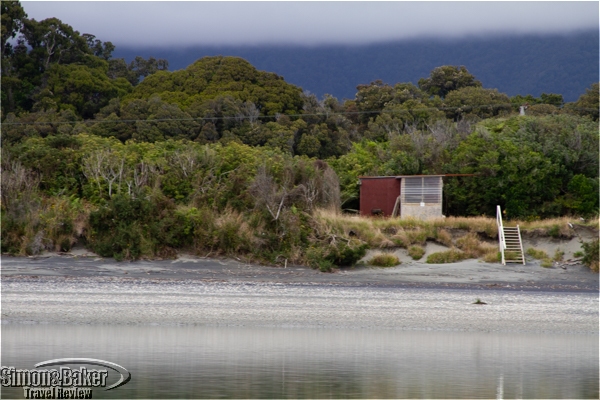
The Waiatoto River, 23 kilometers from Haast and about 200 kilometers from Queenstown
Although it was a clear summer day when we arrived (by the time we returned clouds had descended) there was a chill in the air that promised it would be cooler still on the boat. After applying liberal amounts of insect repellent against the sandflies and donning a loaner coat and I was ready. Veronika Vermeulen, owner of Aroha New Zealand Tours and my guide on an Intrepid tour of the South Island, and I followed Wayne onto a 10-seat KeelowCraft for our two and a half hour private tour. Our boat was 5.7 meters long, 2.2 meters wide, required 125 milliliters of water to operate, and could accommodate up 11 passengers plus driver. It had a Chev 350 V8 petrol engine with a Hamilton 212 jet pump.

The Waiatoto River, part of the U.N.E.S.C.O. Te Wāhipounamu World Heritage Park – click to enlarge
The setting was beautiful. The tour was one of the highlights of my trip to the South Island. The river and lush green vegetation were all around us. After the many crowded attractions we had passed on previous days it was wonderful to be alone on the river. This was in part because the tour was the only way to visit the unspoiled area by land and water. Later Ruth explained by email that the scenery and nature are unique to New Zealand.
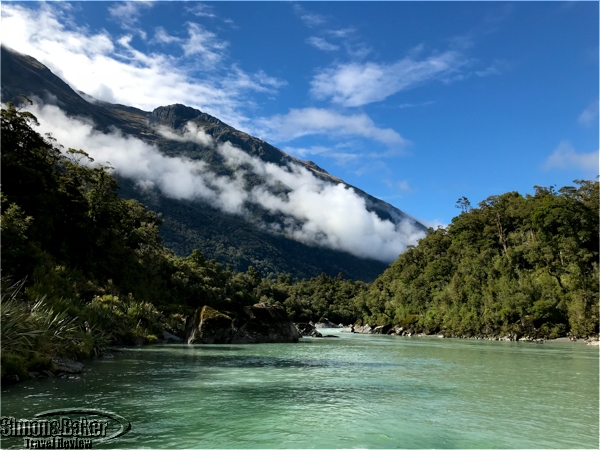
One of my favorite aspects of the tour was that we were the only people visible on the river.
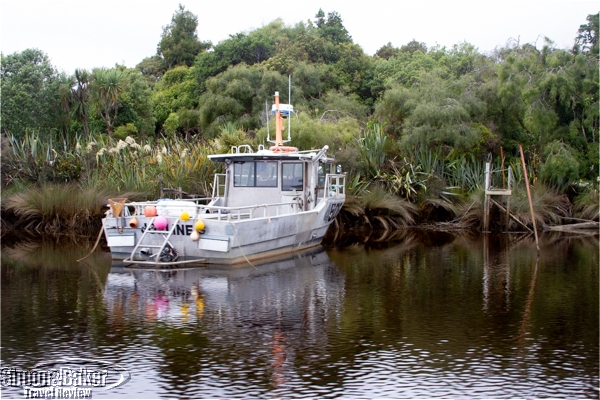
One of few boats we saw although during the whitebait season hundreds of locals descended on the river for their share of the popular fish
The loud engine sounds ensured we focused on the scenery rather than conversation. Wayne slowed down or stopped to show us points of interest, share information and indulge my photo needs. On one of the stops he offered us whitebait snacks. During the whitebait season, hundreds of locals descended on the river for their share of the tiny fish. Although it was past whitebait season Ruth and Wayne had a frozen supply from which they made the snacks.
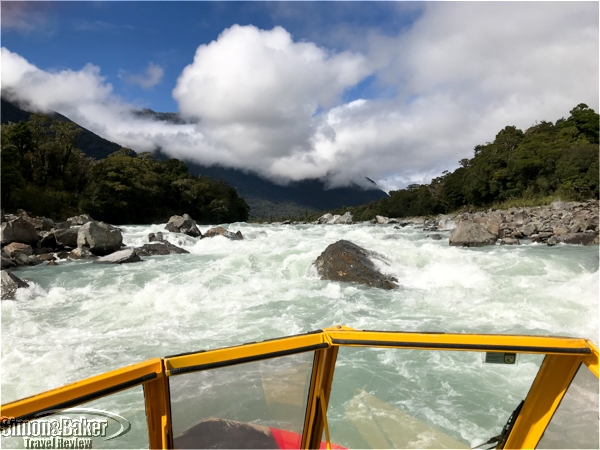
White water on the Waiatoto River
We covered 23 kilometers until the rapids became impossible to navigate. There Wayne tied the boat to the shore. It was easy to step onto land through the front of the boat. Veronika and I gazed at the rushing water, while Wayne secured the boat. Once he joined us we walked 500 meters into the quiet landscape before heading back down the river to the Hindley Stream. By the time we returned to our departure point we had covered 50 kilometers during the tour.
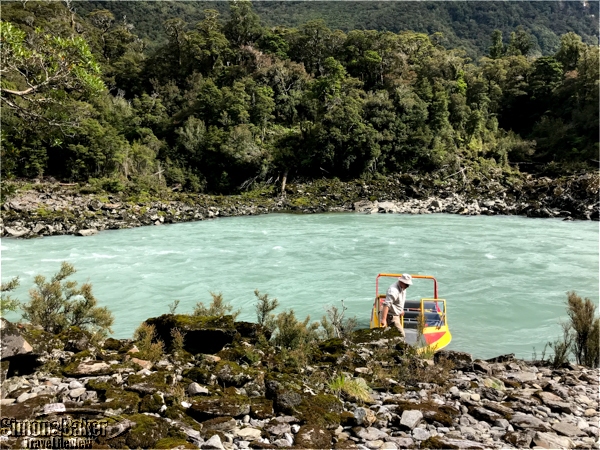
When the river became unmanageable we stopped for a short stroll.
It was nice to know the boats operated with Qualmark Environ motors specially imported for their low fuel use and clean running. I saw no pollution in the water or on land. The Allansons encouraged their clients to “take photos and leave footprints only.”
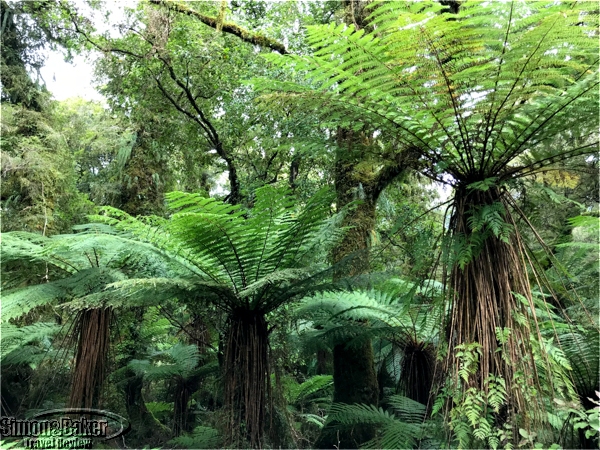
We encountered lush greenery on our short walk.
With advance notice they were able to accommodate some travelers with disabilities. Babies from about 5 months old (provided the life jacket fit) could join their tours and there was no upper age restriction. Life jackets were available up to XXXXL.

At our first stop – click to Enlarge
Once we glided over the river I was glad for the extra loaner layer and the safety of the life vest. Although at one point there were sandflies, perhaps because of the copious quantities of natural repellent I lathered on, they didn’t bother me at all. Waiatoto River Safaris Limited (975 Haast-Jackson Bay road, Hannahs Clearing, Haast, 7844, New Zealand, +64 3 7500 780, www.riversafaris.co.nz, info@riversafaris.co.nz) was owned and operated by a local family since 1997. Theirs was the only company with permission to offer boat tours on Waiatoto River (helicopter companies were allowed enter the park). Ruth and Wayne held Martime New Zealand commercial jet boat licenses, first aid and commercial pilot licenses as well as airplane instructor ratings. They had 12 years of jet boating experience.
According to the U.N.E.S.C.O. website, Te Wāhipounamu World Heritage Park covers 10 percent of the landmass of New Zealand. It has fjords, rocky coasts, towering cliffs, lakes and waterfalls. It was worthy of a detour. I especially enjoyed seeing it by boat.
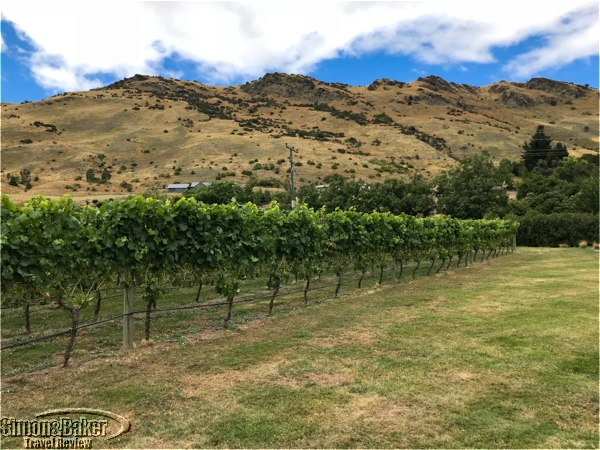
by Editor | Jun 17, 2019 | Food and Wine, Luxury Travel, Restaurants
Article and photos by Elena del Valle
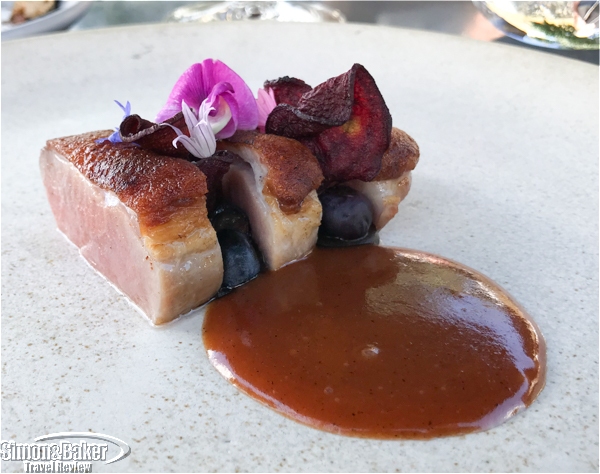
Cardrona Valley lamb neck, garlic yoghurt, pea, umami served with Amisfield Pinot Noir 2016
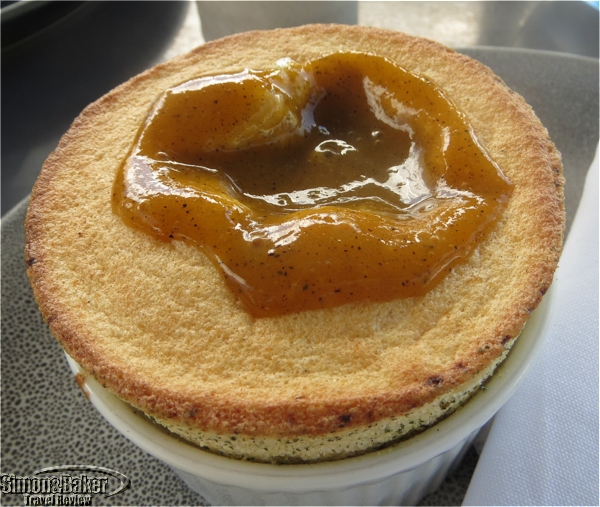
Grilled apricot souffle, lemon verbena
Because I spent most of my trip off the beaten track, on a private Aroha Intrepid tour, my main impression of New Zealand fine dining was derived from lunch at Amisfield Bistro & Cellar Door (10 Lake Hayes Road, RD 1, Queenstown 9371, +64 3 442 0556, amisfield.co.nz, bistro@amisfield.co.nz, cellardoor@amisfield.co.nz), a South Island bistro near Queenstown, where I spent one night. The vineyard side meal was well prepared and well presented, the setting pleasant and pretty. Should I be in the area and in search of a fine dining option I would return, and I would recommend the restaurant to friends and acquaintances traveling to the area.
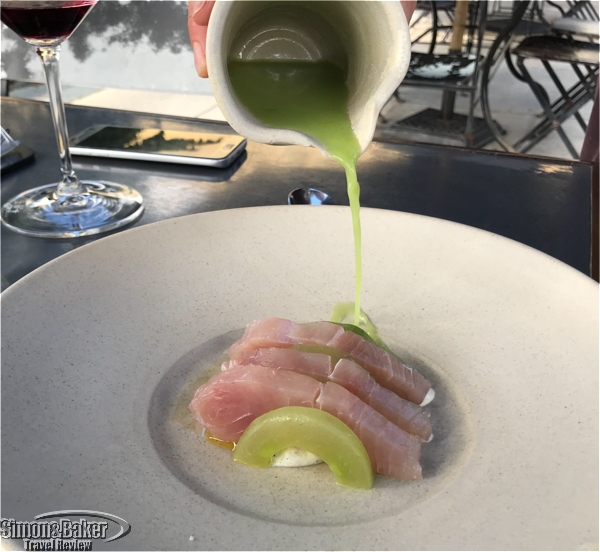
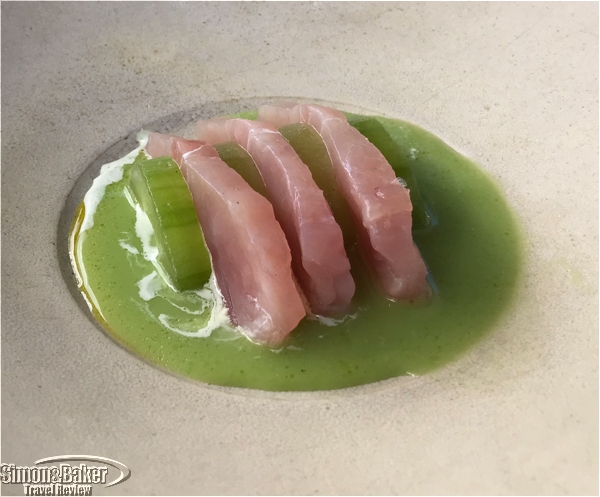
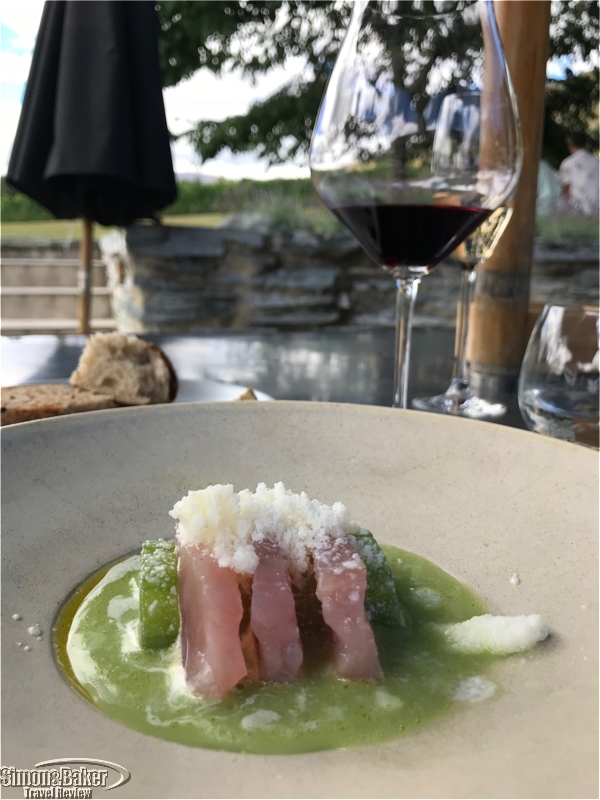
Kingfish, Horseradish, Cucumber
My travel companion and I had lunch there on a breezy and sunny summer day. It was crowded. The restaurant could accommodate up to 100 guests at lunch and 40 at dinner. There were people indoors and outdoors. All the tables I could see from where we sat in the terrace, thankful for the shade of a large umbrella, were occupied. Our table faced a water feature on one side and a green lawn adjacent to the estate vineyards. Despite a mild chill in the air I saw more than one guest take advantage of the respite offered by stacks of sunhats on the edge of the water feature.

Guests took advantage of the respite offered by sunhats on the edge of the water feature.
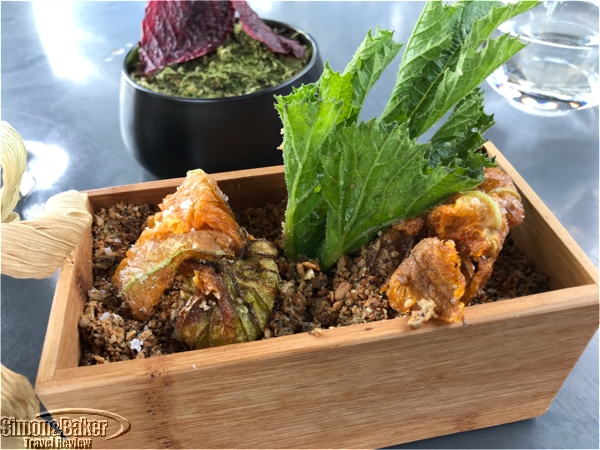
This dish included edible “soil”
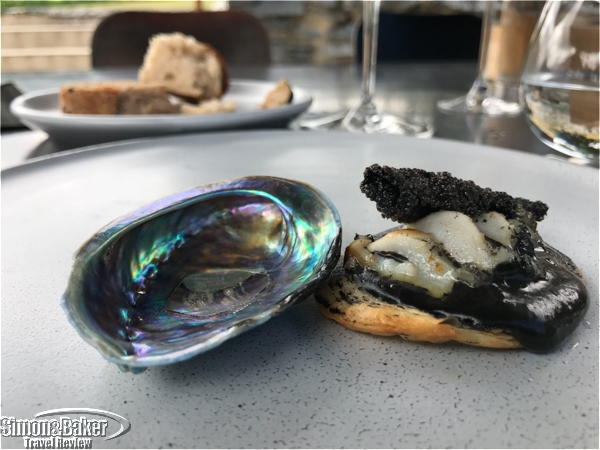
A shellfish delicacy
We both had the 5 Course Trust the Chef tasting menu with a partial wine pairing and a couple of extra bites sent from the kitchen: Zucchini flower Toasted corn; Amisfield Brut 2016, Amisfield breads; Tomato sandwich Amisfield Pinot Gris 2018; The paua pie, Amisfield Fume Blanc 2016; Kingfish, Horseradish, Cucumber, Amisfield Chenin Blanc 2018; Cardrona Valley lamb neck, garlic yoghurt, pea, umami, Amisfield Pinot Noir 2015; Grilled apricot souffle, lemon verbena. Several staff rotated at our table. Whenever a server brought a dish he or she listed the ingredients. Some staff were friendly although service was sluggish. Lunch was inventive, aesthetically oriented and satisfying.
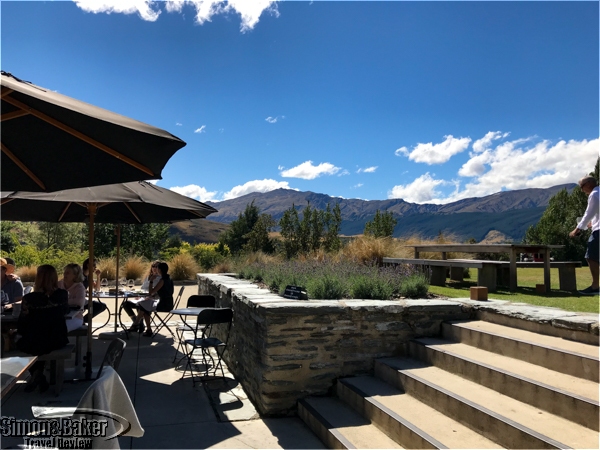
The terrace where we sat for lunch was popular
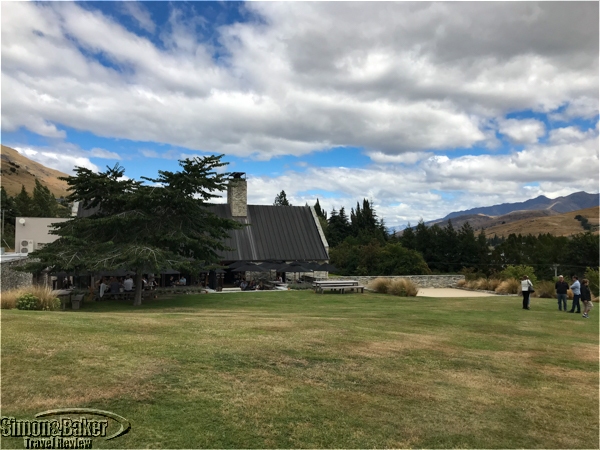
A view of the restaurant built with 1,500 tons of Glenorchy schist and railway sleepers
The two story building was constructed with 1,500 tons of Glenorchy schist and railway sleepers salvaged from a deconstructed bridge in Southland. Headed by Vaughan Mabee, executive chef, the restaurant offered seasonal dishes made from one hundred percent New Zealand ingredients. All meat on offer was grass fed, according to a restaurant spokesperson who responded to questions by email. I liked that the restaurant had an organic produce supplier. The staff only bought sustainable species of fish. Everything was made from fresh, never frozen, ingredients, and the only wines on offer were produced by Amisfield, according to the spokesperson. In 2013, Amisfield began an organic conversion, using as little intervention as possible. The winemaker produced two wines of the natural expression: Amisfield Burn Pinot Gris, an orange wine, and Amisfield Pétillant Naturel.
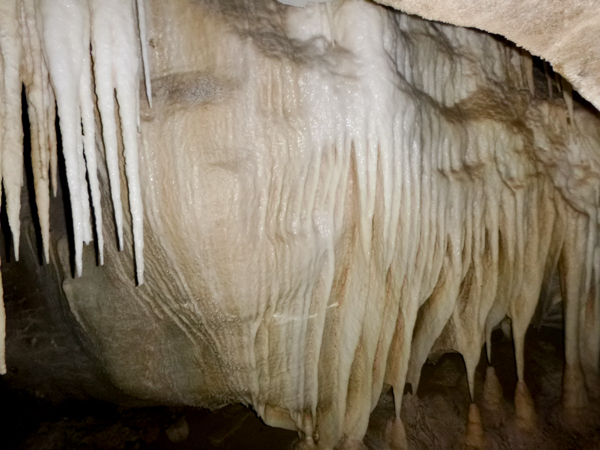
by Editor | Apr 1, 2019 | Attractions, Luxury Travel
By Elena del Valle
Photos courtesy of Underworld Adventures*
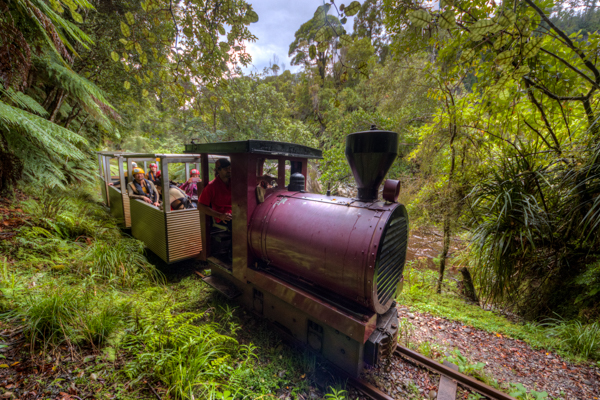
We rode a small train for two kilometers to reach the Metro Cave in the Paparoa National Park in the South Island, New Zealand.
I had been looking forward with a bit of trepidation to Underworld Rafting, a hiking, glowworm viewing and river rafting experience in the Metro Cave Te Ananui Cave of the South Island of New Zealand since Veronika Vermeulen, owner of Aroha New Zealand Tours Ltd. (539C Key Road, RD1, Kinleith, Tokoroa 3491, New Zealand, +64-21-890 611, https://www.arohatours.co.nz/, info@arohatours.co.nz) and my guide in New Zealand, recommended it for inclusion in my custom itinerary. She said if I was open to new experiences and able to hike a short distance in the heat of summer I would like it. I trusted her judgement and agreed to go. When the day arrived I applied liberal amounts of insect repellent to protect me from the New Zealand sandflies as well as sunblock and set aside any concerns. I was glad I did because it was outstanding.
From start to finish the four hour soft adventure within the 430 square kilometer Paparoa National Park in the West Coast was far more fun (and at times more challenging) than I had expected. Following a short drive from Birds Ferry Lodge and Ferry Mans Cottage, where I was staying near Westport, Veronika and I arrived at Underworld Adventures (State Highway 6, Charleston 7892, West Coast, South Island, New Zealand, +64 3 7888 168, www.caverafting.com, contact@caverafting.com) in the late morning.
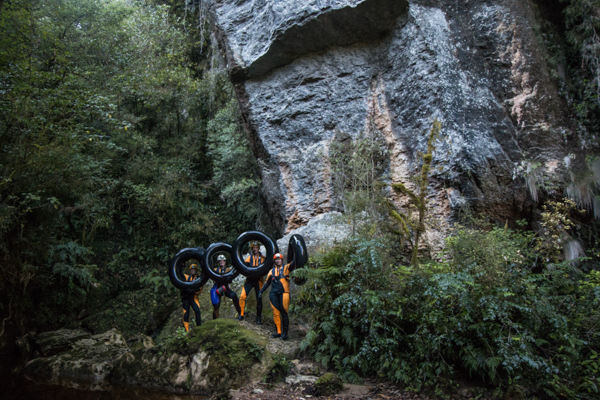
Wearing wet suits we hiked 131 steps to the cave entrance carrying a tube like the ones in the photo.
Mira Schwill, co-manager with Ray Moroney, greeted Veronika warmly. Following introductions we sat at a table in the Underworld Adventures and Café, a sunlit space with a towering ceiling that was the home of Underworld Adventures, to complete our sign-in on a digital tablet. Minutes later we descended to the lower level of the building, where we changed into wet suits and met Peter, our guide. The staff handed each of us a helmet with a light. Although Veronika and I were on private tour with Peter we had to make our way to the cave and back with a tour group. We saw them in the changing area, but they spoke no English and kept their distance when we greeted them. While we waited for the tour group to join us Peter, an energetic and enthusiastic young man who liked to surf as a hobby, outlined our activities and easily answered all my questions.
Once everyone was ready we climbed aboard a weathered van with a small European family. The tour group went on a second van. Ten minutes later most of us boarded a small train with two engines, one gas and another diesel. I later learned the engines, called Dorothy and Cecil, had been built for the company in 2002.
We covered two kilometers with the train. Its leisurely pace allowed me to admire the rain forest vegetation along our path. From the platform we walked about one kilometer along a well marked uneven path to the cave entrance. On the way we picked up large tubes, which while lightweight (they weighed between two and a half and three kilos) were awkward to balance while walking on the slippery ground. This was especially true in the steep last section of 131 steps to the cave entrance and inside.

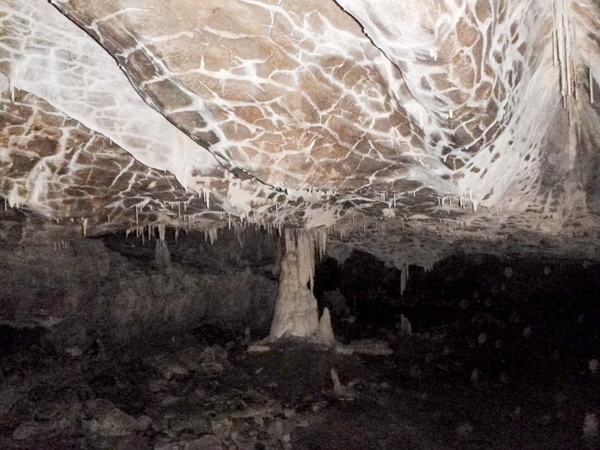
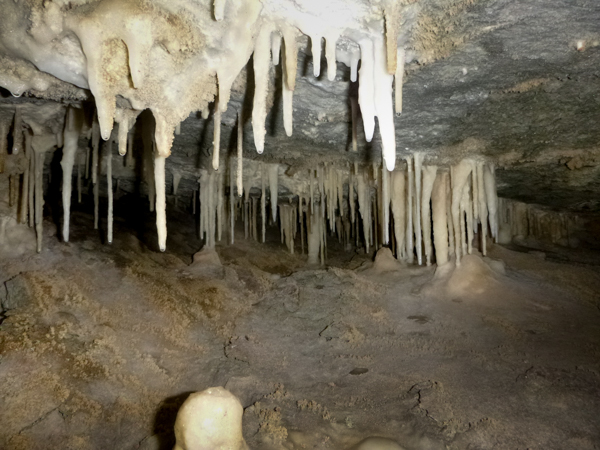
Some of the thousands of stalactites and stalagmites we saw that day
While it had been too warm to zip our wet suits on the way up during the walk inside the cave we could see our breaths in the light of our helmets. It was the only light within the cave. Although I was glad for protection the helmet provided my head It fit loosely and shifted around constantly. We only walked one and a half kilometers of the nine kilometers of the cave. It was slow going due to the low light, pebble strewn uneven surface of the path, shifting helmet, varying height of the cave ceiling and tubes we carried. More than once we were forced to crouch down, while negotiating our balance with the large tube in tow and the helmet moving to an fro.
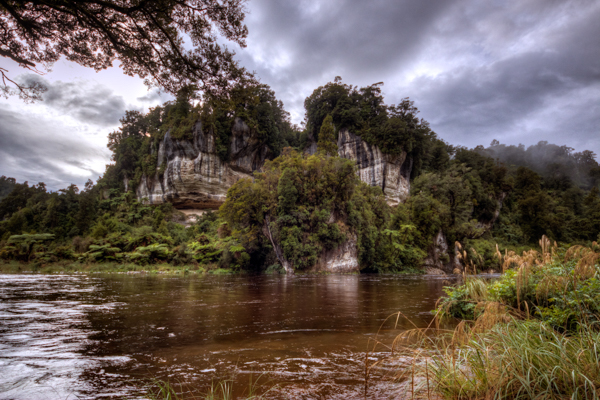
When we exited the cave we floated on our tubes along the Waitakere Nile River.
Inside the cave it was silent and filled in places with thousands of stalactites and stalagmites. There was no sign of the tour group. Peter showed us the cave formations and told us about the man who had discovered the cave. In the serenity of the cave it was as if we were the only ones there like the man who first discovered them carrying matches to break the deep darkness of the unknown within.
Peter watched our slow progress, describing the noteworthy sections of the cave, and offering assistance in particularly tricky segments. After a while I heard the soft sound of moving water. It was almost disappointing because I knew we would soon depart the wondrous world of the cave.
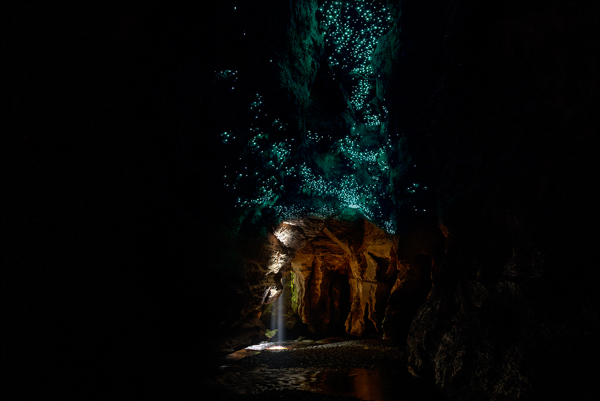
Glowworms in the cave ceiling in the Paparoa National Park in the South Island, New Zealand
But, the glowworms stole the show. We lay atop our tubes, turning off our lights and staring up at the ceiling, which moments earlier had appeared bare. As my eyes adjusted to the dark I began to notice pale worm shapes a few feet above us. When we turned the lights back on I examined the arachnids with interest. From there we walked to the water’s edge and climbed aboard our tubes, making our way past thousands more of the glowing creatures. It was unexpectedly moving.
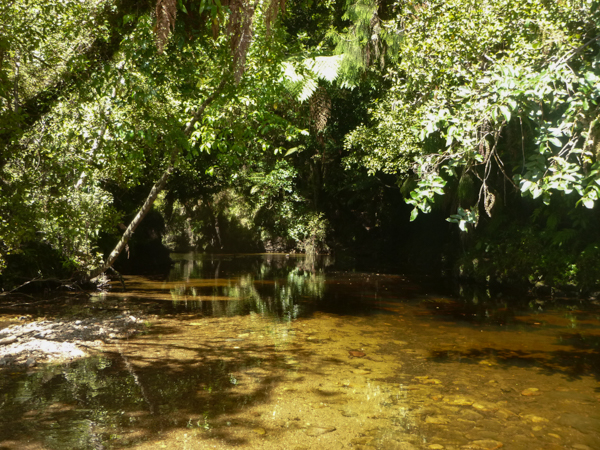
Sun filtered through thick greenery where we floated out of the cave in our tubes.
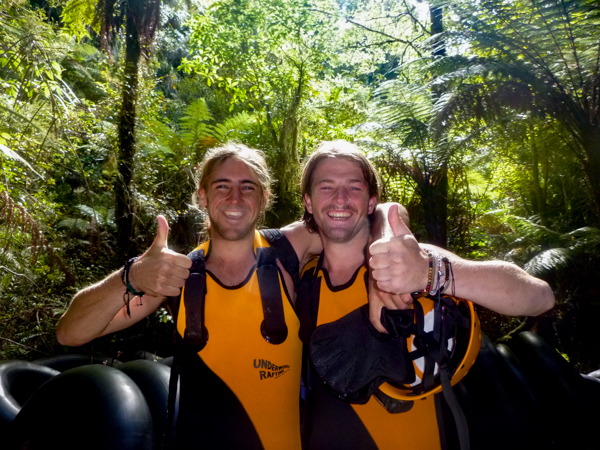
Peter, our guide, and Charlie, who guided the tour group
I was thankful for the wet suit, which kept the chill of the water from cooling me down too fast. The sound of water grew louder and before long we were back in the early afternoon sunshine. The hot sun felt good. I was glad I had sunblock. Around us the river was clean, the water clear as I ran webbed mittens, too large for my hands, in an inefficient yet effortful attempt at steering over the rapids. Peter reminded us to take care as the current carried us one kilometer down the small rapids to our exit point. I was tired and smiling when I walked out with my tube in hand, glad I had followed Veronika’s advice.
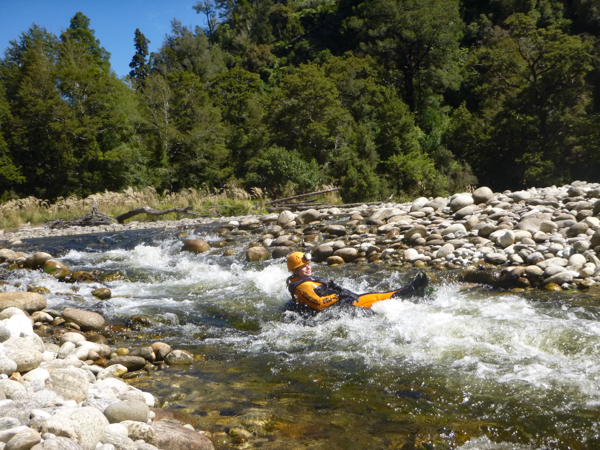 ]
]
Veronika on her way down the small rapids
Our guide had received company training and worked as a guide for three seasons. Underworld Adventures, established in 1987, was owned by Geoff Schurr, Ray Moroney, Stue Berendt, and Graham Howard. It employed nine staff during the off season and fourteen during the high season.
I would recommend Underworld Rafting to my friends who are steady on their feet (there were numerous places were it would have been easy to twist an ankle or loose my footing) while carrying a three kilo tube and a helmet on their heads and in good health. Emergency aid inside the cave could take one to two hours to arrive. Having shared space with a stand offish group during part of the tour I particularly appreciated that mine had been a private tour.
At the conclusion of the tour Underworld Adventures made the photos from that day available for download free of charge. They also provided me with two small printed souvenir photos in an Underworld Rafting sleeve.
*Because I wore a wet suit and didn’t have a waterproof camera I left my camera at the cottage. Additionally, an uneven path and low light conditions in the cave meant special equipment and extra time were necessary for publication worthy photos. Our guide took photos with company equipment during our adventure. The folks at Underworld Adventures kindly allowed us to publish them here along with other photos taken on other dates.
by Editor | Feb 18, 2019 | Attractions, Luxury Travel
By Elena del Valle
Photos by Gary Cox
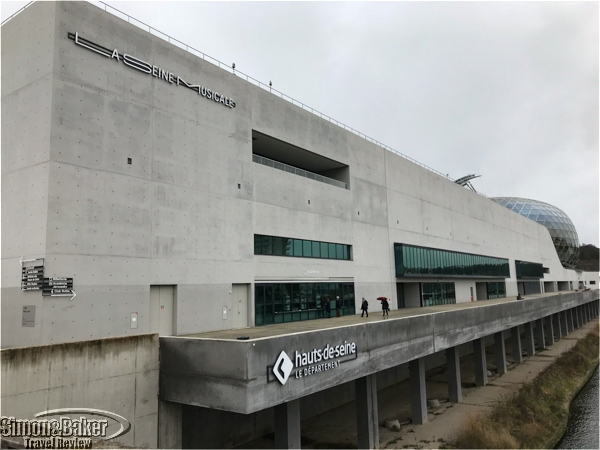
La Seine Musical
On our most recent trip to Paris, France we discovered La Seine Musicale (Ile Seguin, 92 Boulogne-Billancourt, France, www.laseinemusicale.com, + 33 1 74 34 53 53), an events venue opened in 2017 on the outskirts of the city.
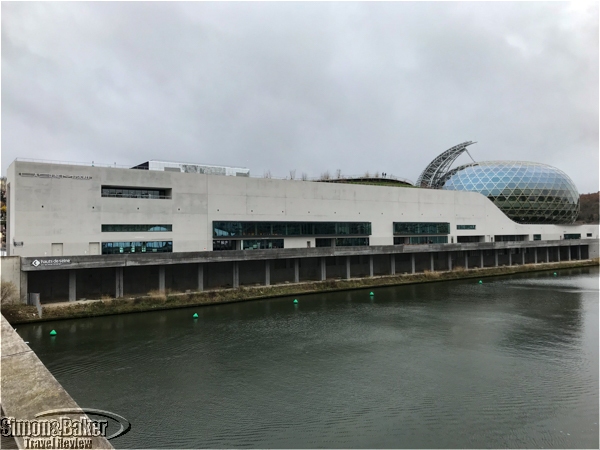
The venue is on an island in the center of the Seine River just outside Paris.
The building, situated on the Seguin Island, has a distinctive architectural design. Inside natural lit filtered past wood and glass walls, drawing us our gaze across the river. The high ceiling gave the building a sense of space.
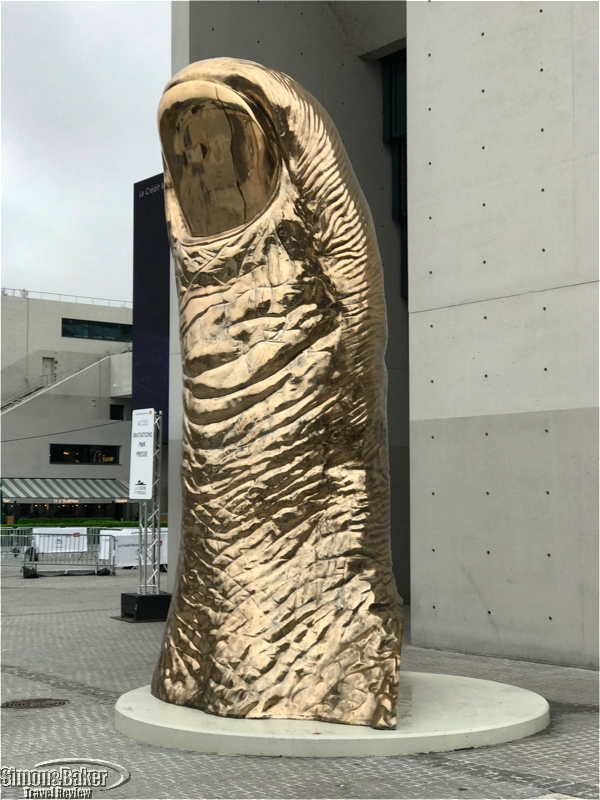
There was a huge sculpture of a thumb in front of the building.
We attended a one hour and fifty minute guitar performance by Liat Cohen accompanied by tenors Rolando Villazon and Charles Castronovo, soprano Sandrine Piau and the Orchestre Pasdeloup. They performed works by Joaquin Rodrigo, Enrique Granados, Jules Massenet, Gabriel Faure, Francisco Tarrega, Isaa Albeniz, Manuel de Falla, Fernando Sor, Tomas Barreras, Rafael Calleja and Tomas Breton. They were fresh from recording Paris-Madrid, an album, that year. It was available for purchase outside the concert hall. Liat’s guitar playing was excellent, earning her repeated applause. It was my favorite part of the show.
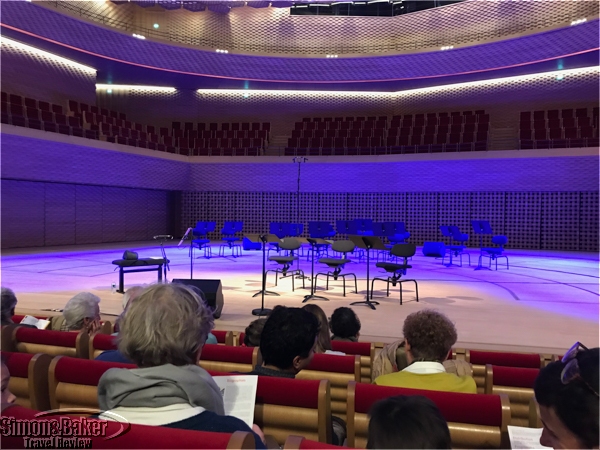
The stage minutes before the start of the performance.
According to her biography Cohen earned First Prize at the Paris Conservatory, graduated from the Schola Cantorum and the École Normale de Musique de Paris; and was the first guitarist to have received the Nadia Boulanger Prize from the Foundation of France.
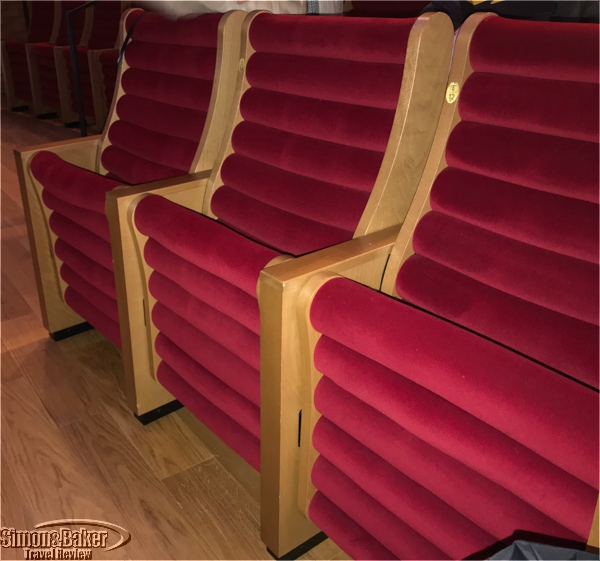
The seats were comfortable and solid.
Our seats (Category 1, E8-10) were comfortable and the view to the stage was unobstructed. Due to photography restrictions we were unable to take photos once the musicians began playing and singing.
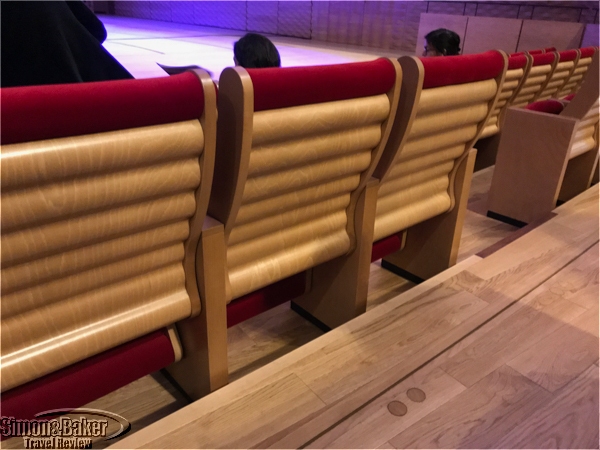
The backs and arms of the seats were blonde wood.
I had read in advance about La Seine Musicale’s rooftop garden, but despite several attempts on arrival and departure it was impossible to visit the garden. Once inside the staff said we couldn’t reach the garden and weren’t allowed to exit and re-enter. At the conclusion of the afternoon show the staff member I spoke with indicated the roof garden was closed.

The walls and ceiling of the theater were covered with a variety of textures and materials.
The theater had two halls with a maximum capacity of 6,000 during 150 shows and an approximate annual attendance of 350,000. The name was derived from the River Seine and the French name for stage, Scène. It was a public private partnership owned by STS Evenements, a joint venture between TF1 and Sodexo.
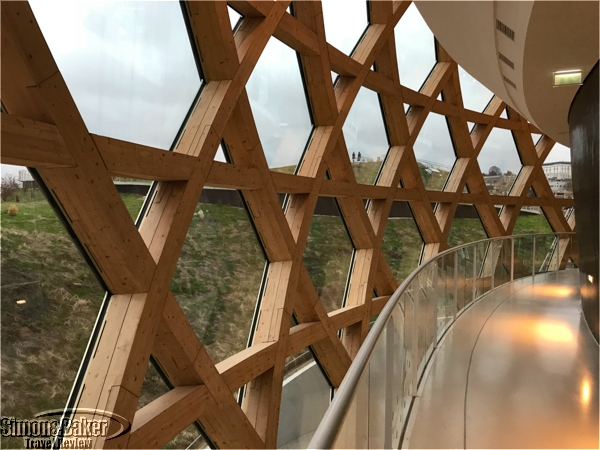
The interior of the dome looking out through solid wood supports
The greatest challenge was that from the Left Bank in central Paris it took us about one hour to reach La Seine Musicale. For a worthwhile performance I would attend a concert there again and recommend it to friends.






















































 ]
]














